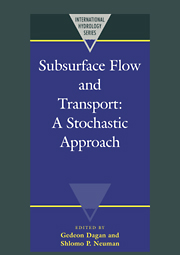Book contents
- Frontmatter
- Contents
- List of contributors
- Preface
- Acknowledgments
- I INTRODUCTION
- II SUBSURFACE CHARACTERIZATION AND PARAMETER ESTIMATION
- III FLOW MODELING AND AQUIFER MANAGEMENT
- IV TRANSPORT IN HETEROGENEOUS AQUIFERS
- V FRACTURED ROCKS AND UNSATURATED SOILS
- 1 Component characterization: an approach to fracture hydrogeology
- 2 Stochastic analysis of solute transport in partially saturated heterogeneous soils
- 3 Field-scale modeling of immiscible organic chemical spills
- VI A VIEW TO THE FUTURE
2 - Stochastic analysis of solute transport in partially saturated heterogeneous soils
Published online by Cambridge University Press: 04 December 2009
- Frontmatter
- Contents
- List of contributors
- Preface
- Acknowledgments
- I INTRODUCTION
- II SUBSURFACE CHARACTERIZATION AND PARAMETER ESTIMATION
- III FLOW MODELING AND AQUIFER MANAGEMENT
- IV TRANSPORT IN HETEROGENEOUS AQUIFERS
- V FRACTURED ROCKS AND UNSATURATED SOILS
- 1 Component characterization: an approach to fracture hydrogeology
- 2 Stochastic analysis of solute transport in partially saturated heterogeneous soils
- 3 Field-scale modeling of immiscible organic chemical spills
- VI A VIEW TO THE FUTURE
Summary
ABSTRACT The problem of solute transport through the unsaturated zone of heterogeneous porous formations is discussed, focusing on mechanistic, stochastic vadose-zone transport models based on two different approaches to modeling flow in these formations, namely the independent vertical columns and the stochastic continuum approaches. It is shown here that the resulting transport models differ in their predictions with respect to (i) how solute spreading evolves with time; and (ii) how water saturation of the formation affects solute spreading. Predictions of transport models based on the first approach are restricted to solute spreading in the longitudinal direction only. Predictions of transport models based on the second approach are in qualitative agreement with the results of numerical simulations of flow and transport in partially saturated, heterogeneous formations, and are consistent with results obtained by the theory of transport by groundwater flow. The need for additional field-scale characterizations of the spatial variability of the soil properties relevant to vadose-zone transport, and for additional, carefully designed field-scale transport experiments and simulations, to validate further existing stochastic transport models, is emphasized.
INTRODUCTION
Quantitative field-scale descriptions of chemical transport in the unsaturated (vadose) zone are essential for improving the basic understanding of the transport process in near-surface geological environments, and for providing predictive tools that, in turn, will be used to predict the future spread of pollutants in these environments. Our interest is focused on transport occurring on the field (formation) scale. One of the distinctive features of a natural formation at this scale is the spatial heterogeneity of its properties that affect transport.
- Type
- Chapter
- Information
- Subsurface Flow and TransportA Stochastic Approach, pp. 196 - 206Publisher: Cambridge University PressPrint publication year: 1997
- 4
- Cited by



